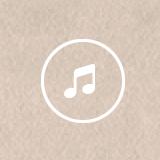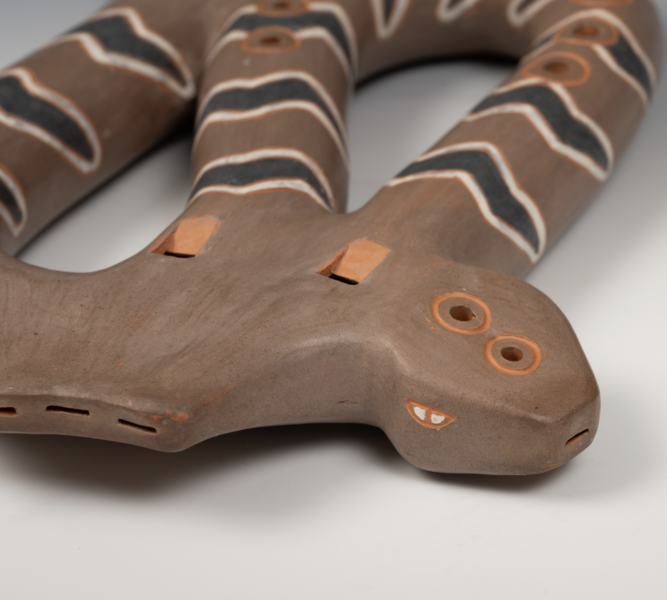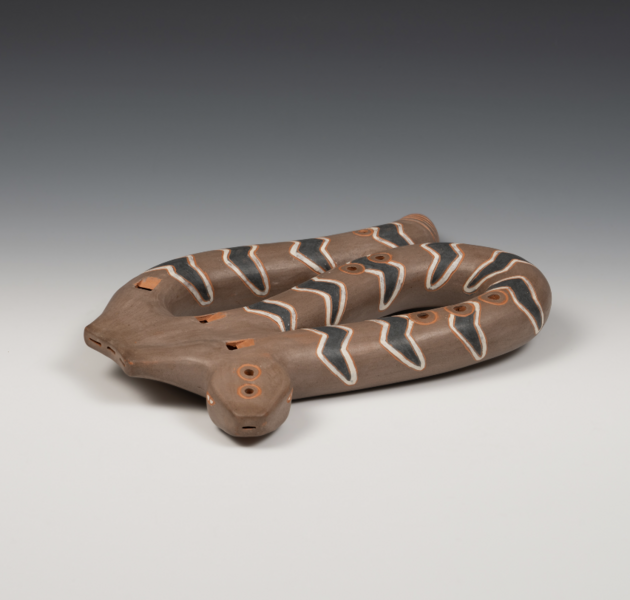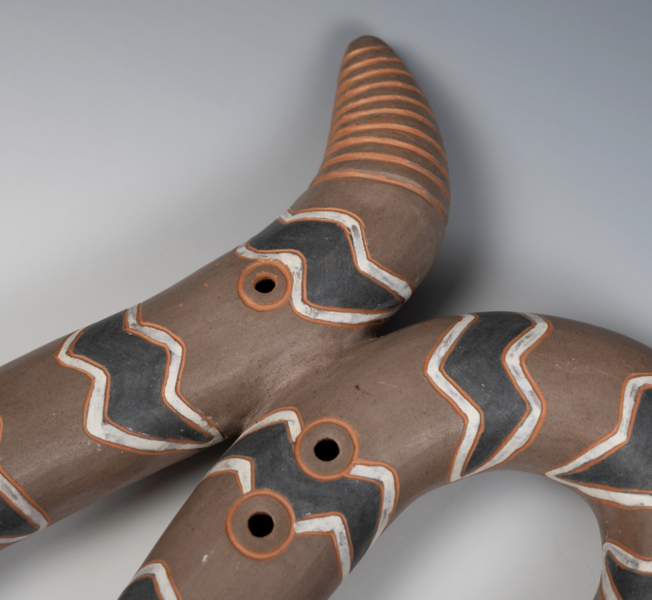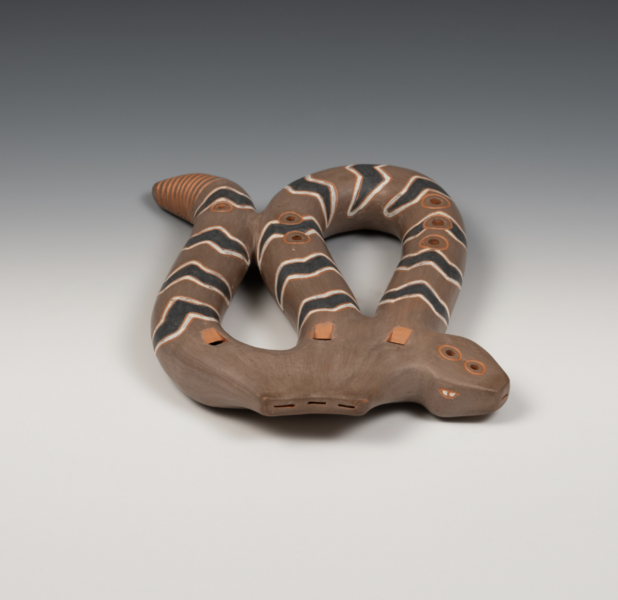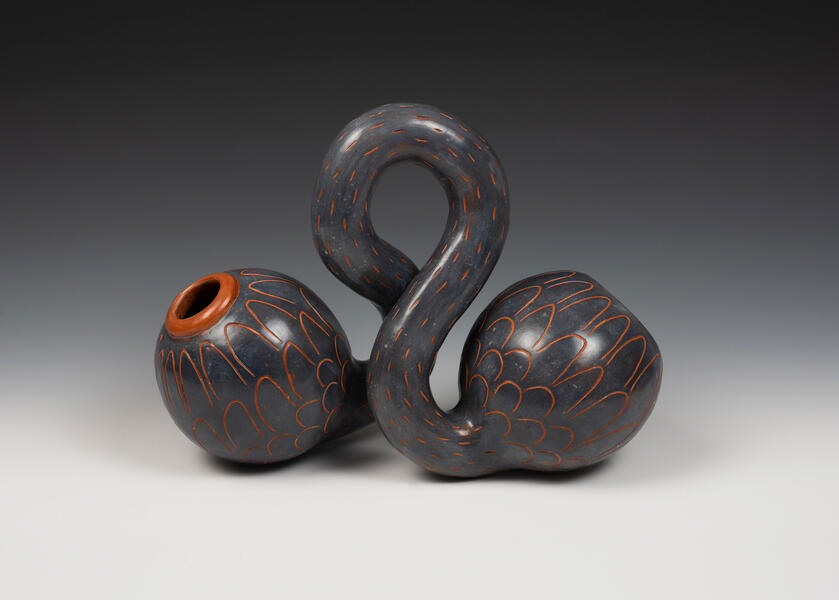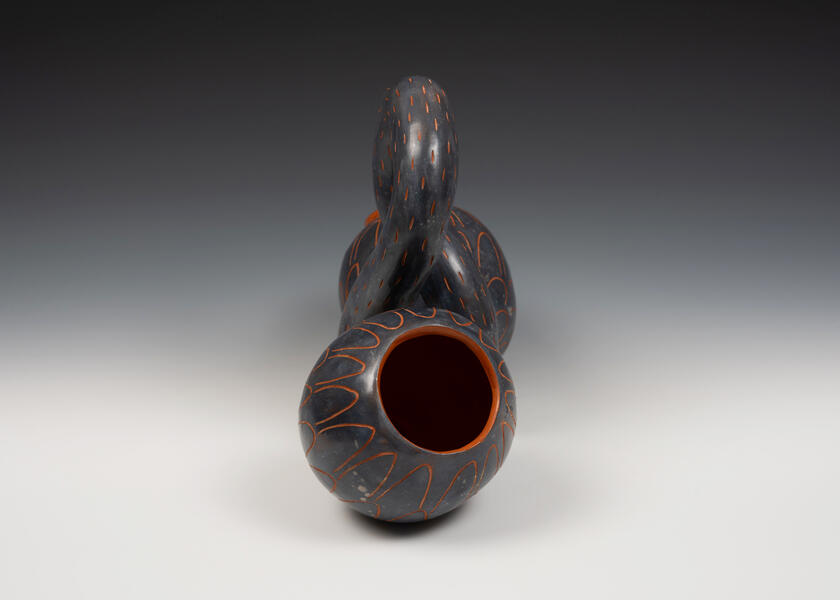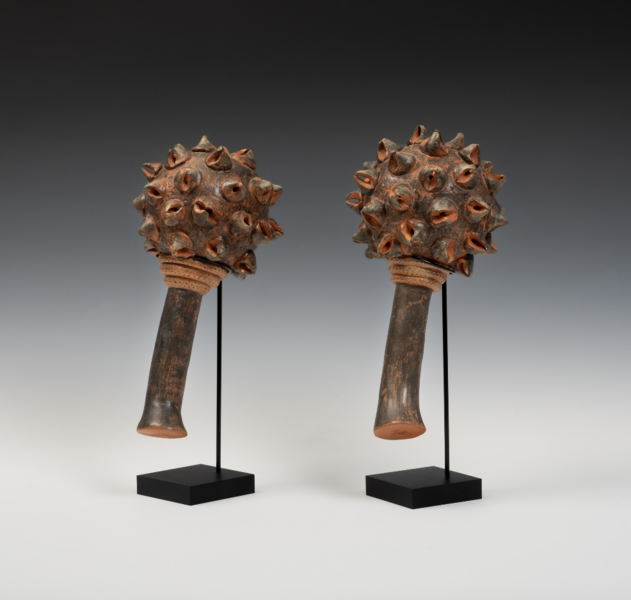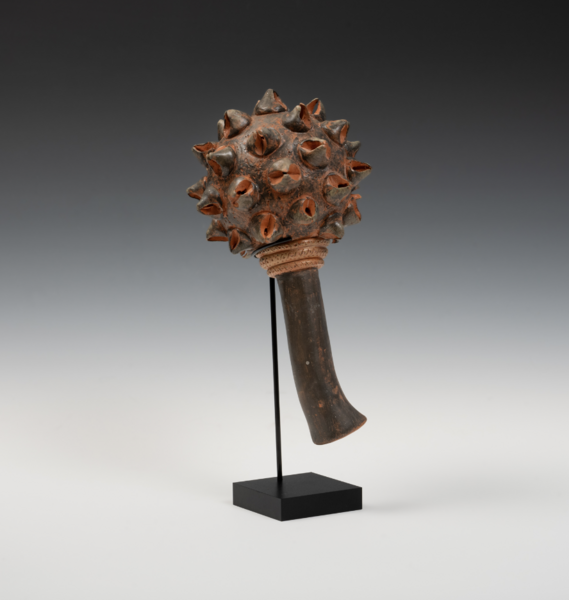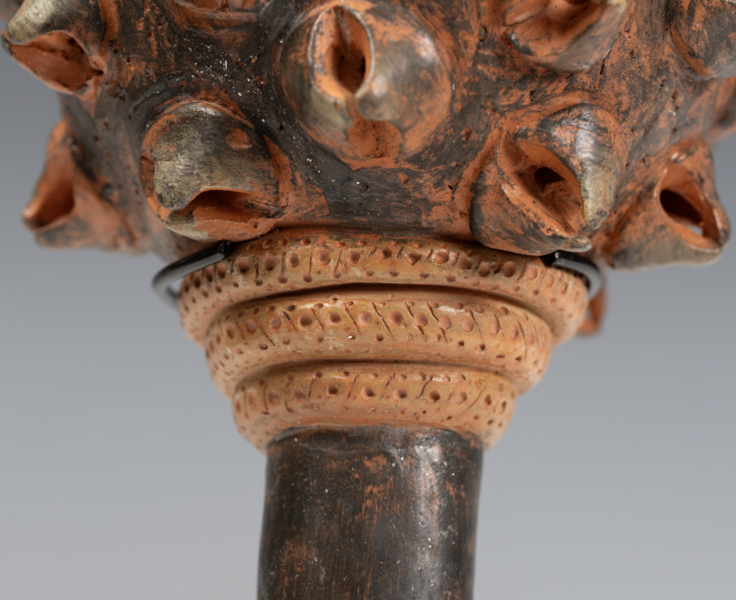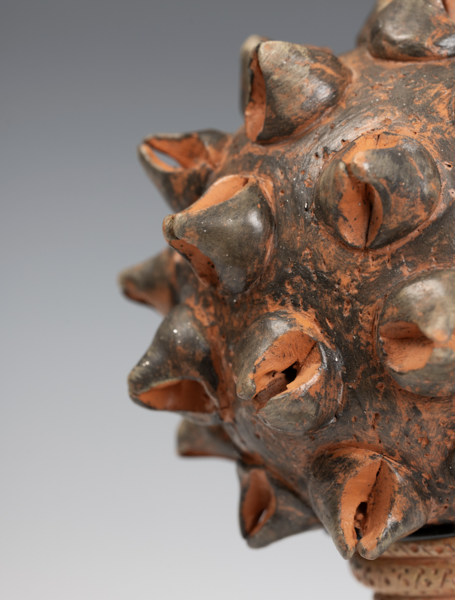Work samples
-
Loon Whistling Bottle
2024
9 x 3.75 x 10.5 in
Earthenware, oxides, pigments, beeswax
I encountered Loon's haunting call throughout my childhood, on regular canoeing trips with my father in Northern Vermont. Those early outings on the water instilled in me a deep appreciation for being in nature. We were always on the lookout for Loon, and spotting her felt like encountering magic. Her soul-stirring call; her perfect markings that looked painted on and her blood-red eyes; the way she'd suddenly dip under water and then pop up halfway across the reservoir. We returned to this reservoir over and over, and it's one of the few natural places that I can return to and still know by heart. Loon's call brings me back to this place that I hold dear.
-
Mineral Mind (Mente Mineral)
2023
7 x 10 ½ x 3 ¾ in
Wild clay, beeswax
Mente Mineral (Mineral Mind) is a more-than-human music mask that is an homage to the mountain range of Chubut, Argentina, which once formed part of the Gondwana supercontinent. The mask was made from material formed within this mountain range, and was created in the context of this majestic landscape.
This music mask was created in the context of an artist residency organized by Nómada Cerámica, where we responsibly harvested local materials, prepared our clay bodies in community, and used this material to sculpt our pieces in situ over the course of 4 days. The wild clays I used to make this piece date back to the Miocene (13 million year old material) and the Paleocene periods (66 Million year old material).
-
No video provider was found to handle the given URL. See the documentation for more information.Palingenesis
2024
Electroacoustic composition
Duration 9 min 12 sec
Palingenesis is a composition for hand built triple flute, tree branches, field recordings, and electronics. The piece is a contemplation on the circular nature of time, both in relation to natural cycles, and the processes of inner healing. Composed with Brain Coral Triple Flute, the piece ebbs and flows along a patient, purposeful journey into the depths of the flute’s unique sonic material, stretching it to its limits and finally disintegrating it completely with digital processing like sampling and granular synthesis before ultimately reaching a quiet corner of focused integration.
Mixing and mastering by Ricardo Wheelock
-
Barred Owl Ocarina
2024
10 x 3.5 x 4.5 in
Earthenware, oxides, pigments, beeswax
Video features a short composition I played, recorded, and produced with this instrument, which is a hand-built vessel flute inspired by Barred Owl.
I have always felt drawn to Barred Owl; astounded by his silent flight and moved by the mystery of his soulful gaze. An elusive one to spot because of his incredible camouflage, we used to look out for him near my father's woodworking shop in Northern Vermont. These days my Mother tells me he nests in the big tree outside her bedroom window, and at certain times of year she can hear his call at night, which I was taught to recognize as "who cooks for you, who cooks for you all".
About Melissa Hyatt
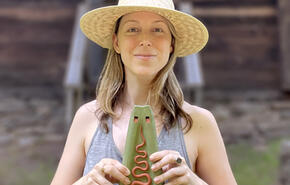
I am an interdisciplinary artist who co-creates with an ever-growing collection of musical instruments, including flutes, horns, trumpets, noise generators, bells, rattles, and whistling bottles, that I hand-craft with clay.
My work takes on different forms: sculptural instruments with intuitive, microtonal tunings; improvisational performances with acoustic instruments and electronics; electroacoustic musical compositions; and educational workshops and residencies for all ages.… more
Original Instruments: Double Flute on display at the Baltimore Museum of Art
In December of 2023 one of my original instruments was installed at the Baltimore Museum of Art, in the new Wall of Wonder; an interactive educational installation in the Patricia and Mark Joseph Education Center.
The Wall of Wonder features digital displays of artworks and artists, discovery drawers with samples of artists’ materials and artworks to touch, and other interactive elements.
My double flute with snake motif sits in a discovery drawer with the theme “Play with Clay” and can be experienced through sight, touch and sound. As part of the display there is a button that can be pushed to play an audio of a short composition I created with the instrument.
For me, having this instrument be part of this initiative contributes to a meaningful shift, where some museums are exploring new ways of engaging visitors of all ages, and involving other ways of perceiving and understanding art.
-
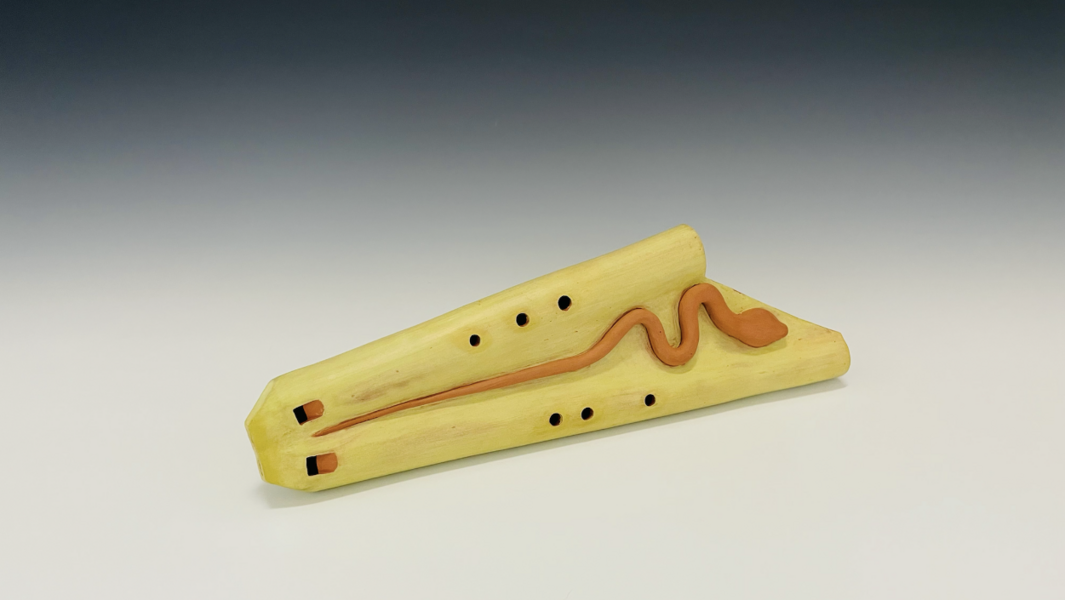 Yellow Double Flute
Yellow Double FlutePolyphonic flute featuring a snake motif and intuitive tuning. This instrument is composed of two different tubular flutes which can be played independently or together to create multiphonic melodies and beat frequencies.
Polyphonic flutes are tubular duct flutes where one instrument can be made up of two, three, or even four different flutes. Oftentimes the flutes have separate air channels so that they can be played individually or in different combinations. These types of flutes have a rich cultural history; they were common to Mesoamerica, made by cultures like the Colima, Aztec, and Maya.
Even though they’re challenging to make, I’ve been drawn to polyphonic flutes because as a musician and composer I find them so exciting. I love being able to play multiple notes at the same time and exploring both harmony and dissonance in the same instrument.
-
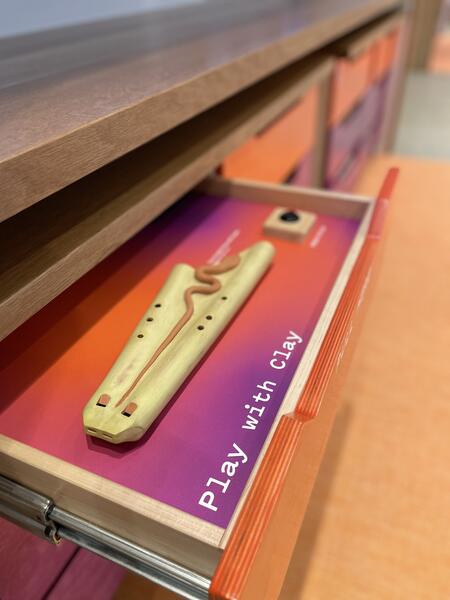 Double Flute in the Wall of Wonder at the BMA
Double Flute in the Wall of Wonder at the BMADouble flute installed in a discovery drawer of the Wall of Wonder
-
Wall of Wonder in the Patricia and Mark Joseph Education Center of the BMA
The Wall of Wonder features digital displays of artworks and artists, discovery drawers with samples of artists’ materials and artworks to touch, and other interactive elements.
-
Double flute installed in a discovery drawer of the Wall of Wonder
My double flute with snake motif sits in a discovery drawer with the theme “Play with Clay” and can be experienced through sight, touch and sound; there’s a button to push that triggers an audio of a short composition I created with the instrument.
-
Short composition with Double Flute
Short composition I recorded, edited and produced with the Double Flute in Ableton Live.
-
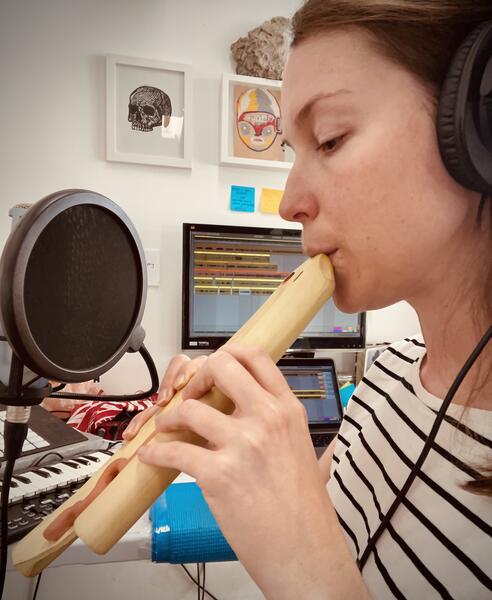 Recording with the Double Flute
Recording with the Double FluteI did recordings with the flute in Ableton Live and then arranged and edited the audio to create a short composition of about 2 minutes.
Commissions: Historical Recreations for the Walters Art Museum
From 2021-2024 I received two commissions to recreate historical musical instruments that are being stewarded in the Walters Art Museum's Art of the Americas collection.
As an instrument-maker, I received my training in a master's program at the National University of Argentina, where we learned to build musical instruments through recreating historic instruments like ocarinas, multiple flutes and whistling bottles, among others. This formation, in addition to my experience as a soloist with the Orchestra of Indigenous Instruments and New Technologies, where I performed with many different kinds of ancient instruments, has given me a profound understanding of the acoustic systems, construction, and techniques of playing many little-known ceramic instruments.
I began working with curatorial and conservation staff at the Walters Art Museum in 2019, to research ceramic whistles and flutes of the ancient Americas. The Walters has a number of ancient ocarinas, flutes, and other aerophone instruments from different parts of the Prehispanic Americas in their collection, however, in an art museum they were understood largely on the basis of their visual qualities.
Working replicas allow for much more complex research into the sonic qualities of these objects without extensive handling or alteration of delicate artifacts; some of which date back over 1,000 years. Using in depth visual analysis, detailed measurements, and x-radiography, these historic recreations are built and sculpted to be as identical to the original instruments as possible, both in function, form, and iconography. These replicas will allow the museum to present works to the general public in a way that does not only show their visual qualities, but will be able to present the original artifacts as the authentic, creative sound-making, multipurpose objects that they were in antiquity. In this way, the museum will offer a more accurate view of the participatory, communal rituals of the past.
These historical recreations will be utilized in exhibition, demonstrations, and educational programming in connection with the permanent installation of the Latin American Art exhibition, which will open in May of 2025.
-
Historical recreation of a Sicán-Lambayeque Whistling Bottle
Whistling bottles are complex instruments that were produced by different cultures from about 1500 BCE to 1500 CE, in a wide geographical area stretching from Peru to Mexico. No traces of their original uses have yet been found. These instruments are composed of a system of hollow tubes and vessels and produce sound through one more or more small whistles. They can be played by blowing into their spouts to activate the whistle, and some can be played through the movement of water in their interior, which pushes air out through the whistle as the instrument is rocked back and forth.
This whistling bottle features two small whistles, which are embedded in the base of the stirrup where it connects to the backs of two pelicans. When the instrument is played, by blowing into the vertical spout, the air travels through the spout, through the rectangular vessel, and up through the hollow bodies of the pelicans, to activate the whistles.
-
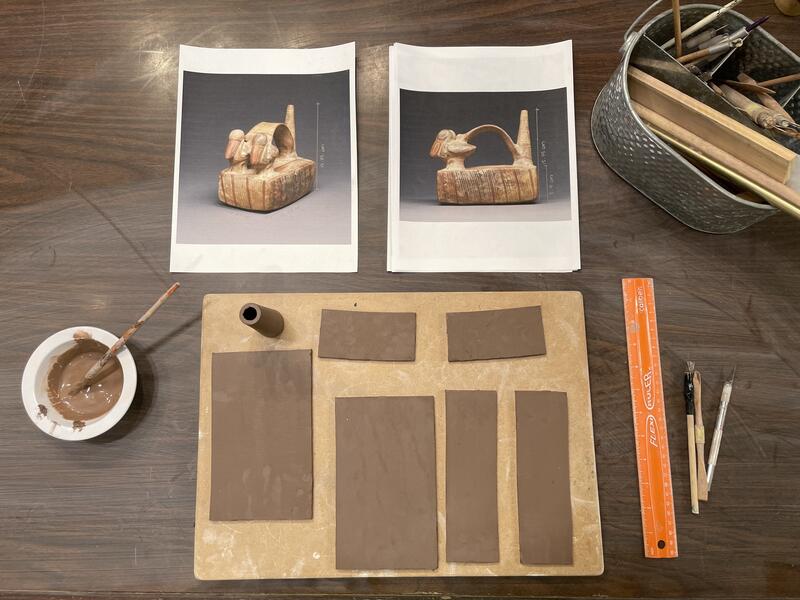 Historical recreation in process
Historical recreation in process -
Historical Recreation of a Whistling Bottle from the Sicán-Lambayeque culture of ancient Peru
This video features a short composition I played, recorded, and produced with the instrument shown in the image, which is an historic recreation of a Whistling Bottle from the Sicán/Lambayeque culture of Peru.
Whistling bottles are sophisticated sound artifacts composed of systems of hollow vessels, tubes and whistles. These complex instruments were made for about 3,000 years by many different cultures across Peru, Ecuador, Colombia and as far North as Mexico.
This whistling bottle has two pelicans, each with a small whistle embedded in the stirrup near its back. The whistles can be activated either by blowing into or across the spout of the instrument, or through movement of water in its interior.
The original object is stewarded by the Walters Art Museum and forms part of their Art of the Americas collection.
-
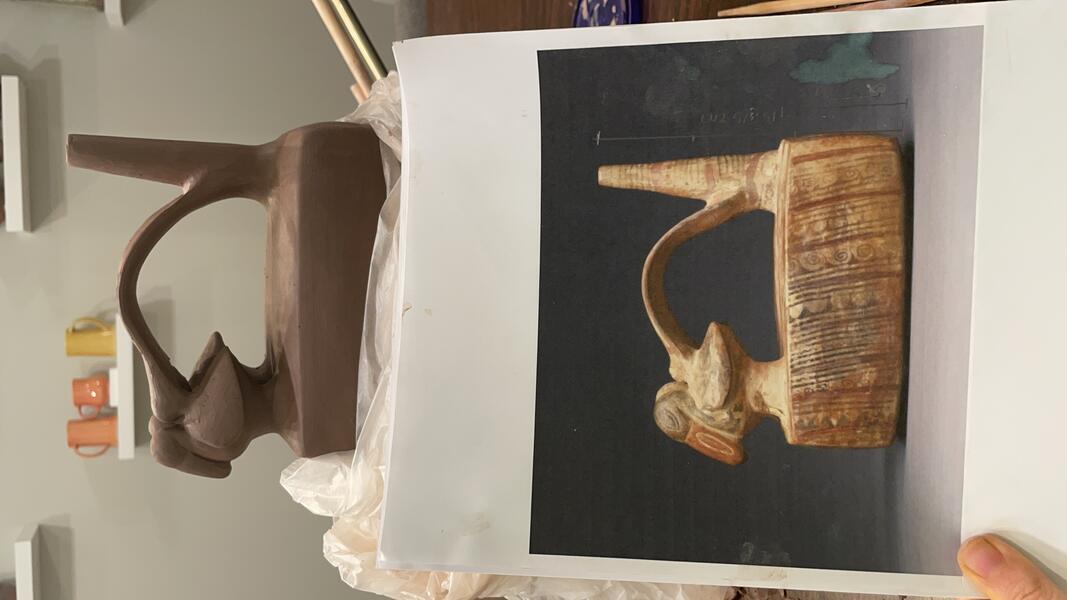 Historical recreation in process
Historical recreation in process -
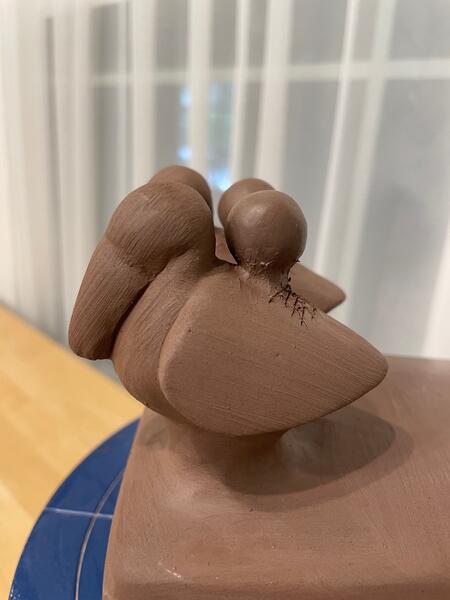 Historical recreation in process
Historical recreation in processImage shows a detail of the whistles embedded in the back of each pelican.
-
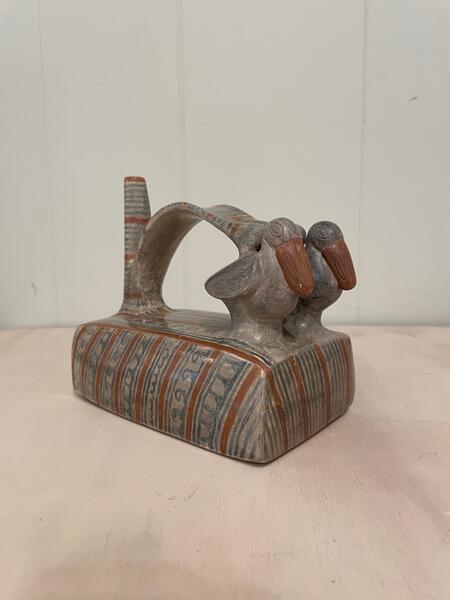 Image of finished historical recreation before firing
Image of finished historical recreation before firingImage shows the historical recreation finished with traditional techniques: painting with colored engobes and burnishing.
-
Historical recreation of a Sicán-Lambayeque Whistling Bottle
-
Historical Recreation of a Whistling Bottle from the Sicán-Lambayeque culture of ancient Peru
Performer: Soloist with the Orchestra of Indigenous Instruments and New Technologies of Argentina
From 2012 - 2019 I performed as a soloist with the Orquesta de Instrumentos Autóctonos y Nuevas Tecnologías of Argentina (Orchestra of Indigenous Instruments and New Technologies - OIANT).
The OIANT was created in 2004 at the National University of Argentina at Tres de Febrero (UNTREF) by Alejandro Iglesias Rossi and Susana Ferreres. Hailed by the international press as a “shamanic orchestra for a technological age”, this artistic-academic project brings to life hundreds of Indigenous musical instruments in immersive audiovisual experiences that blend traditional folk music with contemporary compositions.
Their performances join the evocative sounds of hand-built replicas of rare pre-Columbian instruments like whistling bottles, polyphonic flutes, and slit-drums, with cutting-edge electronic technology, and traditional masks. The OIANT has toured across 5 continents with what is the world’s largest collection in-use of Indigenous instruments, whose origins reach from Alaska to Argentina, and the project was recipient of the UNESCO’s Musical Rights Award in 2013.
During my time with the Orchestra I was a multi-instrumentalist, playing a large range of instruments including: Ocarina, Tarka, Siku, Pututu, Bastón, Zumbador, Vasija Silbadora, Silbato de la Muerte, N'viké, Turú, Pinkullo, Teponaztli, Huéhuetl, Sonajero, and Rama. We played in important concert halls of Buenos Aires, Argentina, including the Teatro Colón and the Ballena Azul of the Centro Cultural Kirchner, and toured across the country as well as in France, Puerto Rico and Cuba.
As part of my experience with the Orchestra, I was also involved in instrument-building, costume construction, set design and construction, choreography and re-orchestration of contemporary works with Indigenous instruments.
-
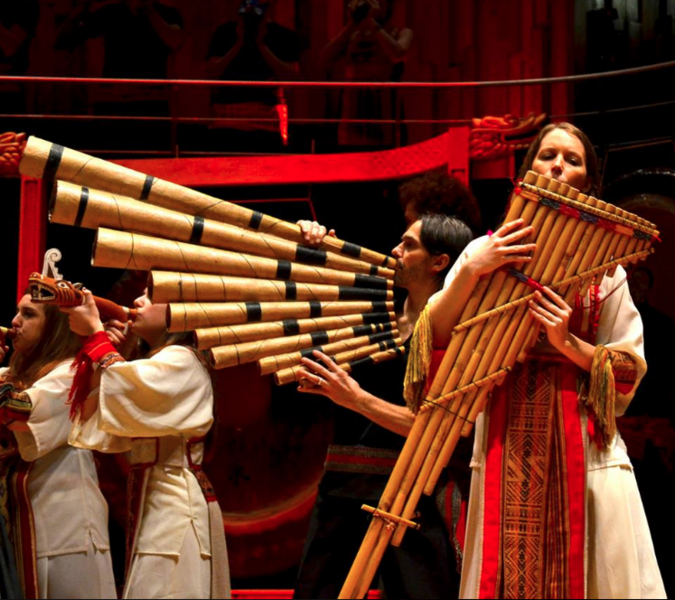 Performance in Buenos Aires
Performance in Buenos AiresImage from performance at the Centro Cultural Kirchner in Buenos Aires, Argentina.
I am playing a bamboo Siku, or panflute, collected by the Orchestra with a Peruvian instrument-maker.
-
Excerpt from performance in Córdoba, Argentina
Excerpt from "Antara" a composition by Chilean composer Carlos Zamora, during a performance at the Regional Conference of Higher Education of Latin America and the Caribbean (CRES 2018) in Córdoba, Argentina.
-
Performance of Entonces en la Escala de la Tierra
Performance of "Entonces en la Escala de la Tierra", a composition by Susana Ferreres for sculptural ocarinas, whistling bottles, double flute, and noise generators.
-
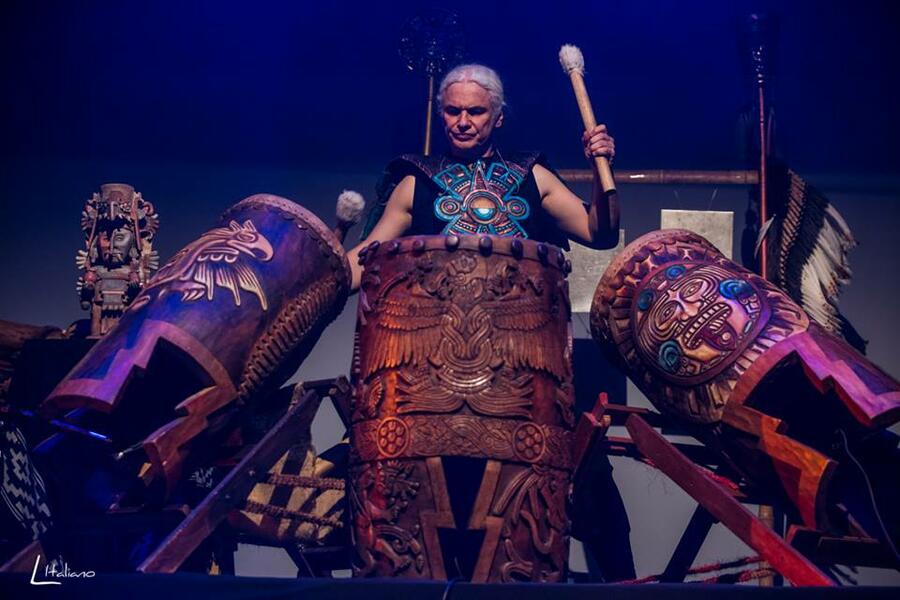 Alejandro Iglesias Rossi, Creator and Director of the OIANT
Alejandro Iglesias Rossi, Creator and Director of the OIANTAlejandro Iglesias Rossi on stage playing three Huéhuetls, which are traditional carved wooden drums that were used by the Aztec and other cultures in Mexico. These instruments were collected by the Orchestra with a contemporary Mexican drum-maker.
Alejandro Iglesias Rossi (Buenos Aires, 27 de julio de 1960) is an Argentine composer, director, researcher, and educator. He has received two emblematic musical distinctions from UNESCO: the "First Prize of the International Tribune of Composers" (Paris, 1985) for his work Ancestral Rites of a Forgotten Culture, and the "First Prize of the International Tribune of Electroacoustic Music" (Amsterdam, 1996) for his work Angelus.
At the National University of Argentina at Tres de Febrero, Iglesias Rossi created the Orchestra of Indigenous Instruments and New Technologies. There he is director of the Master's Degree in Musical Creation, New Technologies and Traditional Arts, and of the Bachelor's Degree in Indigenous, Classical and Popular Music of the Americas, and also directs the Center for Ethnomusicology and Creation in Traditional and Avant Garde Arts (IDECREA).
Iglesias Rossi is a founding member of the Musical Research and Creation Network of America (RICMA), and he is president of the Argentine Music Council and vice-president of the Music Council of the Three Americas of the International Music Council of UNESCO.
-
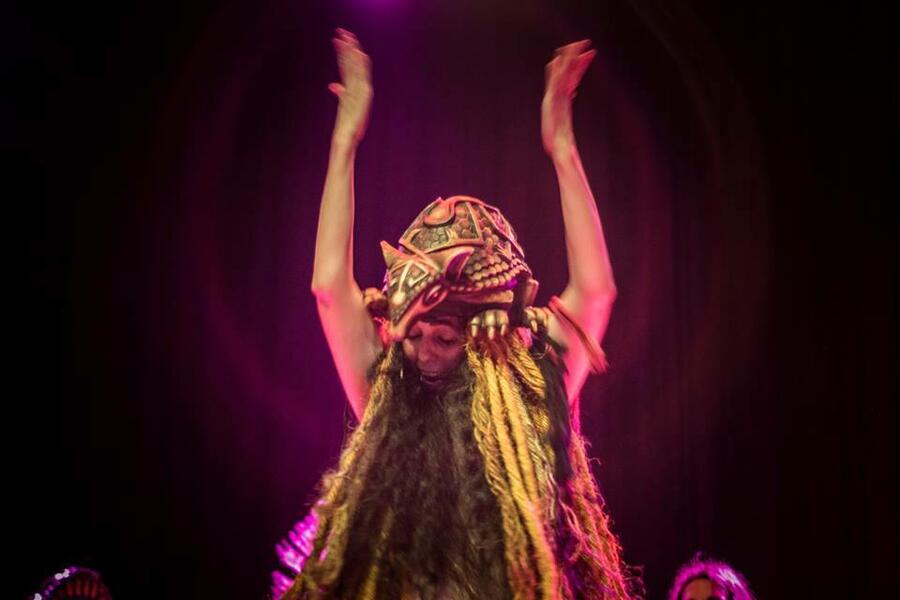 Susana Ferreres, Visual and Scenic Arts Director
Susana Ferreres, Visual and Scenic Arts DirectorImage from a concert at the Teatro Colón in Buenos Aires, of Susana Ferreres, the Visual and Scenic Arts Director of the Orchestra of Indigenous Instruments and New Technologies.
Ferreres is wearing a sculptural Armadillo headdress, which she designed and fabricated herself.
Susana Ferreres is a multidisciplinary artist and has dedicated her life to researching the Indigenous iconography of the Americas as well as the Eastern Byzantine and the medieval West. In 2004, together with the ethnomusicologist Isabel Aretz and the composer Alejandro Iglesias Rossi, she founded the Center for Ethnomusicology and Creation in Traditional and Avant-garde Arts at the National University of Tres de Febrero. There, she directs the Iconographic and Corporeal Research Program in Sacred Art and created the first Program for the Recovery of Indigenous Instruments and Traditional Masks of the Americas.
She is director of performing and visual arts of the Orchestra of Indigenous Instruments and New Technologies. There her body of iconographic work is intertwined with avant-garde creation, giving rise to an artistic-academic model that is taught in the Bachelor's Degree in Indigenous, Classical and Popular Music of the Americas and in the Master's Degree in Musical Creation, New Technologies, and Traditional Arts. Ferreres produces and directs the creation of the sets, costumes, choreography, and masks that the Orchestra has presented in concerts around the world.
-
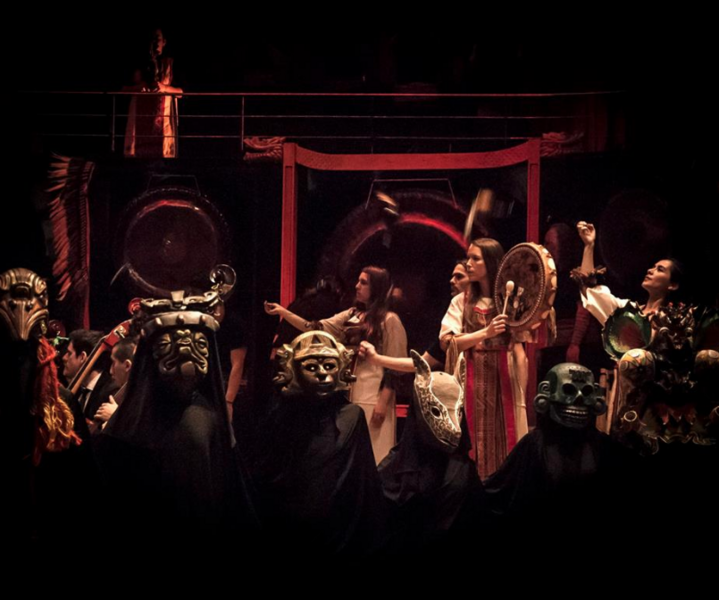 Performance at the Centro Cultural Kirchner
Performance at the Centro Cultural KirchnerImage from a performance at the Centro Cultural Kirchner in Buenos Aires, Argentina.
I am playing a Lakota hand drum made by Sonja Holy Eagle. This instrument was collected by my adopted Uncle Mark Van Norman, of the Cheyenne River Sioux Tribe, who gifted it to the Orchestra in 2017.
-
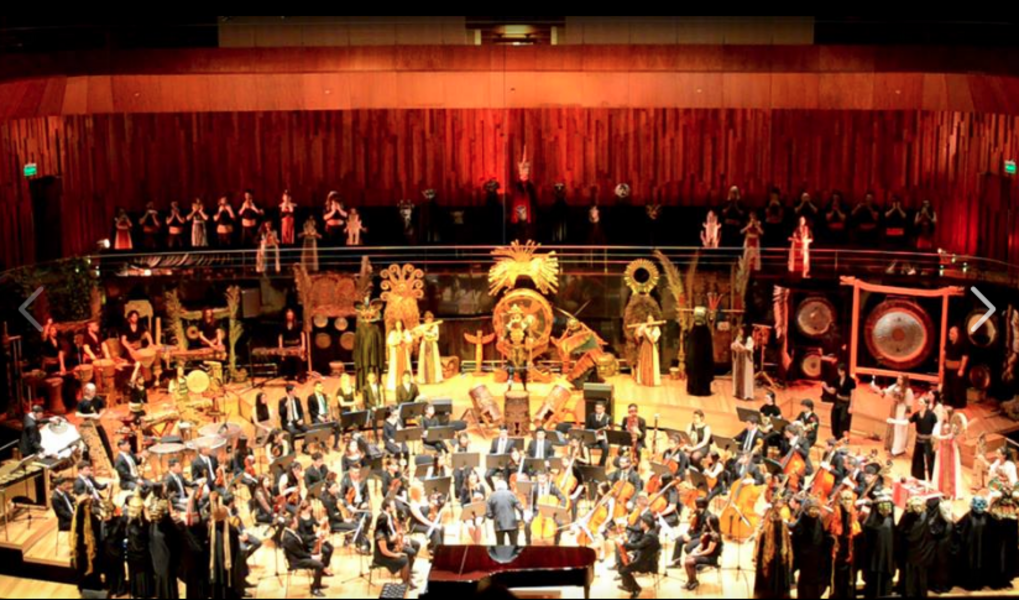 Performance at the Centro Cultural Kirchner
Performance at the Centro Cultural KirchnerImage from performance at the Centro Cultural Kirchner in Buenos Aires, Argentina, where the OIANT performed together with the Orquesta Sinfónica Juvenil Nacional San Martín (National San Martín Symphonic Youth Orchestra)
-
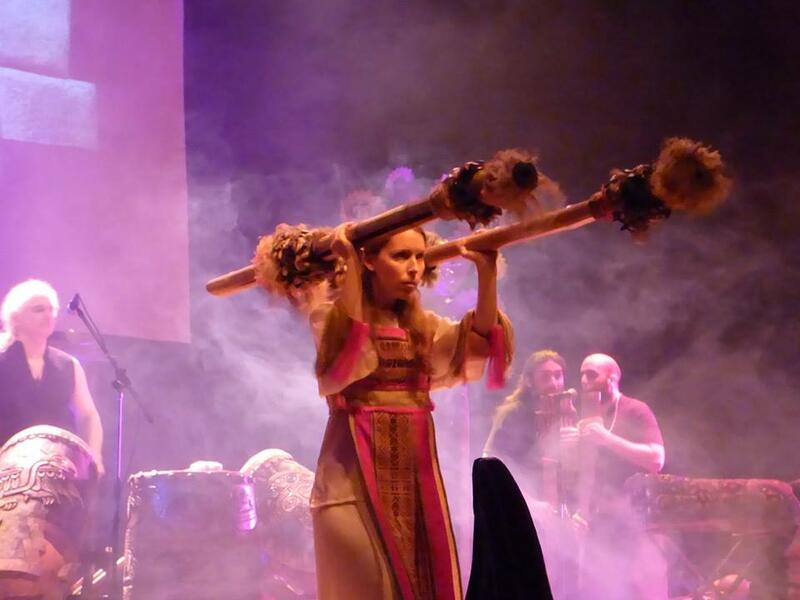 Performance in Havana, Cuba
Performance in Havana, CubaImage from a performance at the Leo Brouwer Festival de Música de Cámara in Havana, Cuba.
I am playing instruments called "bastones" that were made by members of the Orchestra.
-
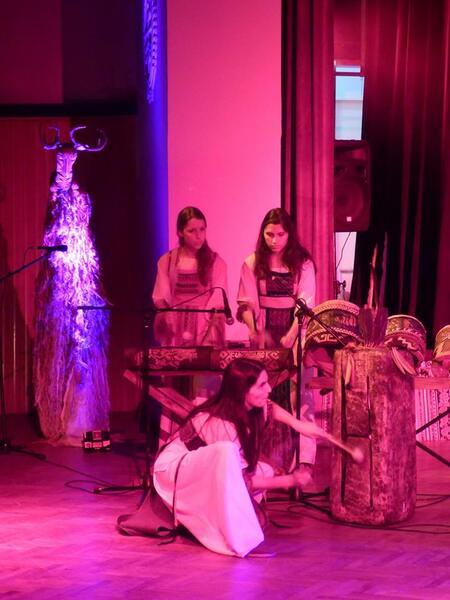 Performance at the Teatro Colón
Performance at the Teatro ColónImage from performance at the Teatro Colón in Buenos Aires.
Musicians are playing Teponaztli and Huéhuetls, which are hand-carved traditional drums that were used by the Aztec and other cultures of ancient Mexico. These percussion instruments were collected by the Orchestra with a contemporary Mexican drum-maker.
-
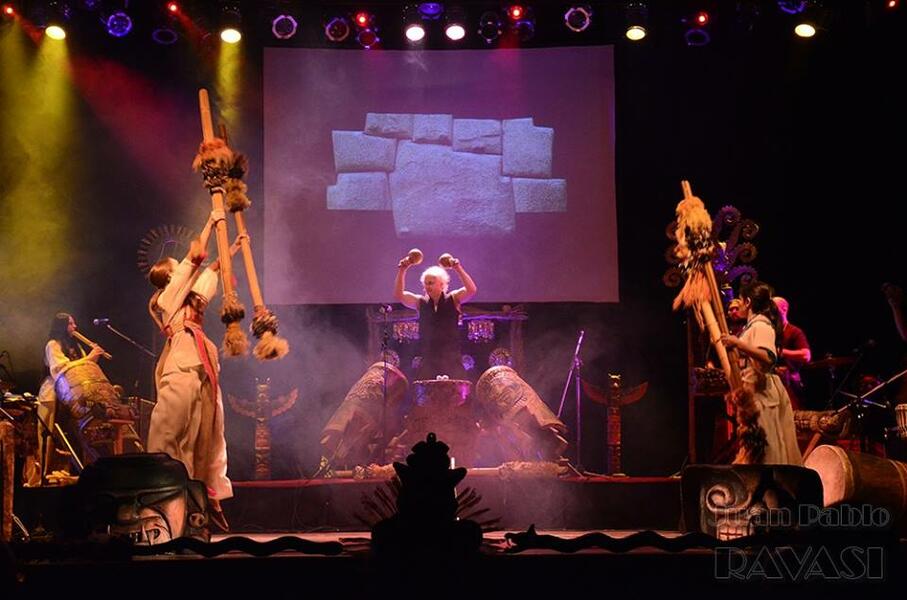 Performance at the Teatro Colón
Performance at the Teatro ColónImage from a concert at the Teatro Colón in Buenos Aires.
I am playing instruments called "bastones", which were made by members of the Orchestra.
Original Instruments: Timber Rattler Triple Flute
When I first returned to the US from Argentina, I was spent a lot of time hiking on a trail I know well, in the small city where I grew up. One day I had an encounter with Timber Rattler. I heard her first, and upon hearing that rattling sound my body instinctively and immediately responded with racing heart and a rush of adrenaline. I stumbled back a few steps as I frantically scanned the ground. I finally spotted her, about 10 feet ahead of me. She'd been crossing the trail I was on and we'd clearly startled one another. I froze and waited. She stopped rattling and did the same. After a few moments I felt the tension dissipate. She began flicking her forked red tongue, and continued on her way. I was stunned by her beauty; her markings and the way she moved across the earth.
This instrument is composed of three different tubular flutes and a small whistle in the snake's head. Each of the three flutes can be played independently or together to create multiphonic melodies and beat frequencies.
Polyphonic flutes are tubular duct flutes where one instrument can be made up of two, three, or even four different flutes. Oftentimes the flutes have separate air channels so that they can be played individually or in different combinations. These types of flutes were common to Mesoamerica, made by cultures like the Colima, Aztec, and Maya.
2024
6.5 x 8.5 x 1 in
Earthenware, oxides, pigments
Community Engagement: Mud to Music
My teachers in Argentina instilled in me the importance of passing on these instrument-making practices, and I was recruited to begin teaching early on in my studies in Buenos Aires. I began assisting in extracurricular classes and workshops before becoming an adjunct professor in instrument-making classes within the bachelor's program in Música Autóctona, Clásica y Popular de América (Indigenous, Classical and Popular Music of America) at the National University of Argentina at Tres de Febrero (UNTREF)
After 12 years in Argentina, I returned to the US in 2021. Through sharing these arts here, I continue to honor my teachers; further integrate what I've learned; raise awareness of the instrument-making traditions developed by Pre-Columbian cultures across Central and South America; and cultivate embodied cross-cultural connections. On a personal level, sharing these practices in Maryland and beyond has helped me to re-root myself in my lands of origin; bringing me into deeper relationship with myself, weaving me into community, and enriching my understanding of the place and time in which I am living.
Communing with people of all ages through instrument-making continues to reveal lessons about the depth of our collective relationship with clay and sound, the power of music to create moments of shared emotion, and the sense of presence and vitality that naturally results from coming together in a circle, big or small, to create in community.
Since returning to the US in 2021, I have shared instrument-making in English and Spanish with hundreds of people of all ages and backgrounds in workshops, classes and residencies, at schools, museums, cultural centers, libraries and universities.
-
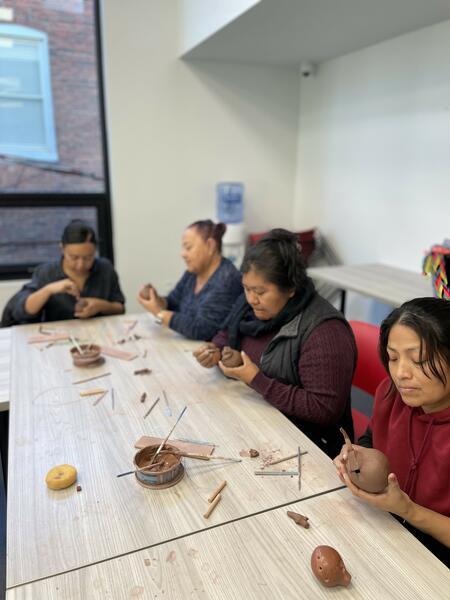 Flute-making workshop at Creative Alliance
Flute-making workshop at Creative AllianceThis flute-making workshop was part of a bilingual workshop and class series given at Creative Alliance over the course of 2024, with the support of an Arts in Education grant from the Maryland State Arts Council.
This program was prepared in collaboration with the non-profit arts organization Creative Alliance; their bilingual department Creative Immigrant Educators of Latin American Origin (CIELO); their in-house Latinx organization Artesanas; and their multicultural hub for education, the Creativity Center.
The Mud to Music programming series was developed for English and Spanish-speaking youths and adults ages 15+ and half of the activities were offered in English and half in Spanish.
-
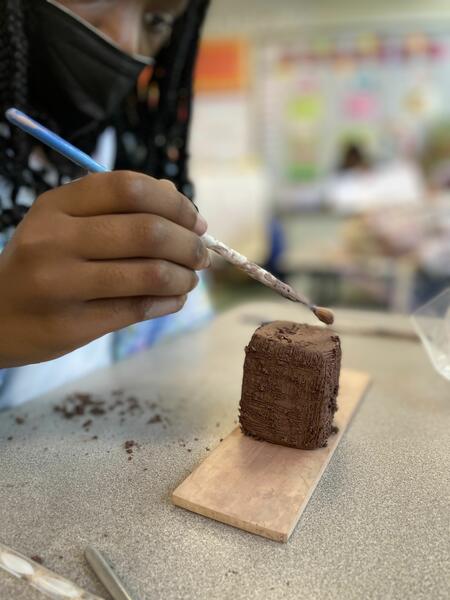 Rattle-making residency at Capitol Heights Elementary School
Rattle-making residency at Capitol Heights Elementary SchoolIn 2023 I worked with the Capitol Height Elementary School to offer a 5-session artist-in-residence. The Mud to Music rattle-making residency program engaged 5 classrooms for a total of 125 students and 5 classroom educators.
Over the course of our sessions, students were introduced to different Pre-Columbian instruments like whistling bottles, polyphonic flutes, and ocarinas, and learned through a step-by-step process to construct and decorate their own working clay rattles using time-honored hand building techniques and simple pottery tools. Each student was encouraged to explore individual creativity through sound design and decoration, in order to create an instrument that would be unique in both sound and form.
-
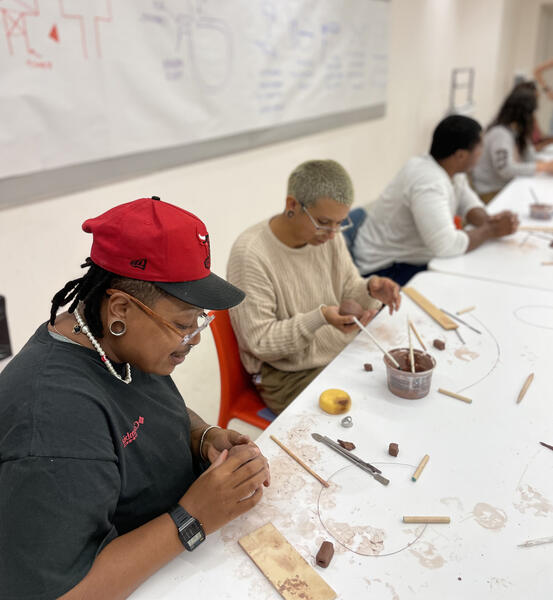 Flute-making workshop at the Baltimore Museum of Art
Flute-making workshop at the Baltimore Museum of ArtIn November 2022 I gave a free flute-making workshop at the Baltimore Museum of Art as part of the museum's BMA Maker Series.
I lead a tour of instruments in the museum’s Indigenous Arts of the Ancient Americas collection and we discussed the sophisticated ways that Pre-Columbian cultures have used sound, music, iconography, and sculpture to express their world visions. Participants then learned through a step-by-step process to build their own clay flutes using ancient pottery-making techniques. Engaging in this practice helped us to contemplate the relevance of ancestral wisdom in our world today.
This workshop was offered with the support from the Maryland State Arts Council.
-
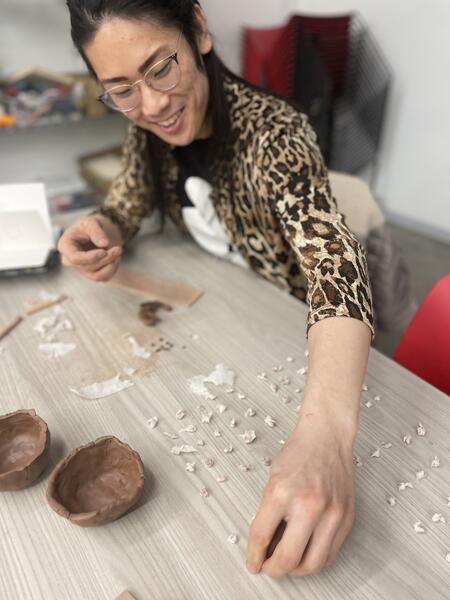 Rattle-making workshop at Creative Alliance
Rattle-making workshop at Creative AllianceMusical instruments have helped us communicate and express ourselves since the beginning of human culture. Learning about the musical instruments of the ancient Americas and building and playing our own instruments helps us to awaken the memory of our connection to nature, cultivate presence through working with clay, and experience joy through sound and music-making. In this hands-on workshop we learned about musical instruments that have been made across Central and South America for thousands of years and learned to build our own working clay rattles.
This rattle-making workshop was part of a bilingual workshop and class series given at Creative Alliance over the course of 2024, with the support of an Arts in Education grant from the Maryland State Arts Council.
-
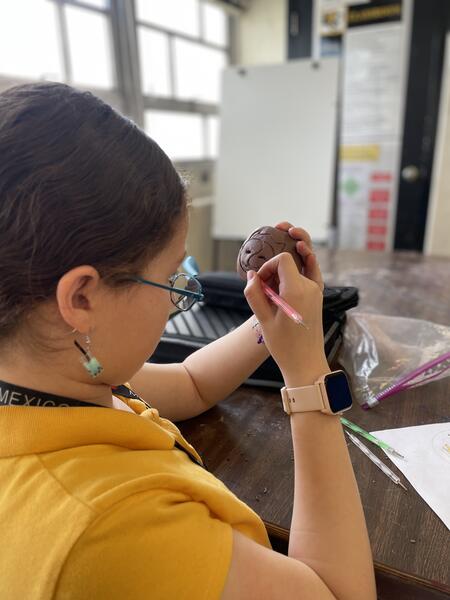 Rattle-making residency at Neelsville Middle School
Rattle-making residency at Neelsville Middle SchoolIn 2024 I worked with the Neelsville Middle School to deliver an 8-session artist-in-residence to support the school's activities and objectives. The Mud to Music rattle-making residency program engaged 5 classrooms for a total of 180 students and 3 classroom educators. Over the course of our sessions, students were introduced to different Pre-Columbian instruments like whistling bottles, polyphonic flutes, and ocarinas, and learned through a step-by-step process to construct and decorate their own working clay rattles using time-honored hand building techniques and simple pottery tools. Each student was encouraged to explore individual creativity through sound design and decoration, in order to create an instrument that would be unique in both sound and form.
Even though rattle-making is an historic and "low-tech" art practice, I have been very pleased to see the levels of enthusiasm and engagement in both elementary and middle school aged children, and school teachers have noted this as well. There is something about working with clay that tends to draw us in, no matter our age. And the act of building an instrument, where we are not only shaping clay but also sound, is particularly captivating.
-
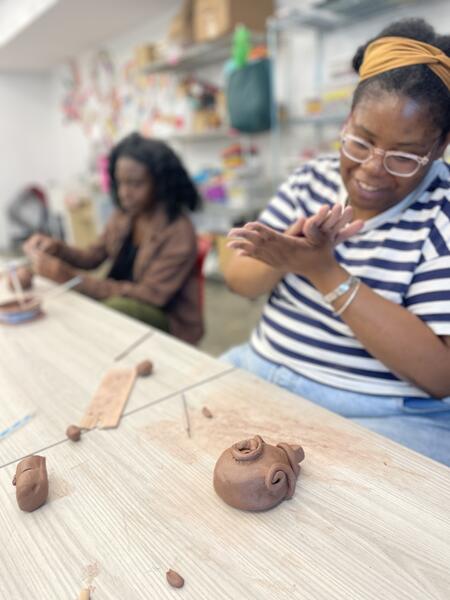 Flute-making intensive at Creative Alliance
Flute-making intensive at Creative AllianceIn this hands-on class, participants got an in-depth introduction to the Ocarina, a type of globular clay flute that has been made for thousands of years in Central and South America. Over the course of four sessions, we built an understanding of and confidence with the skills needed to design, build, and decorate both simple and sculptural clay flutes.
Throughout the course of the workshop participants were introduced to different types of historical and original hand-built musical instruments; learned to construct a simple ocarina and designed and built a zoomorphic (bird or animal-shaped) ocarina; and were introduced to traditional finishing techniques like painting with engobes and burnishing.
This longer-format class was an excellent opportunity for participant's unique creativity to shine. I encouraged us to consider different animals, birds, and other more-than-human beings with whom we feel a closeness or kinship. These became the basis for our sculptural instruments, which were a more advanced project that we were able to take on once we had an understanding of the construction of simple ocarinas.
This flute-making class was part of a bilingual workshop and class series given at Creative Alliance over the course of 2024, with the support of an Arts in Education grant from the Maryland State Arts Council.
-
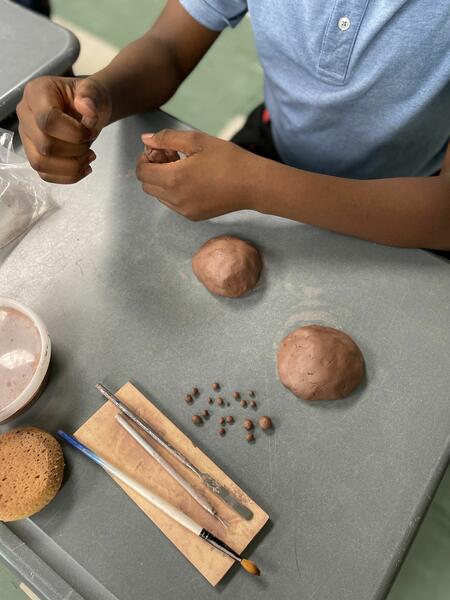 Rattle-making residency at Capitol Heights Elementary School
Rattle-making residency at Capitol Heights Elementary SchoolIn 2023 I worked with the Capitol Height Elementary School to deliver a 5-session artist-in-residence. The Mud to Music rattle-making residency program engaged 5 classrooms for a total of 125 students and 5 classroom educators. Over the course of our sessions, students were introduced to different Pre-Columbian instruments like whistling bottles, polyphonic flutes, and ocarinas, and learned through a step-by-step process to construct and decorate their own working clay rattles using time-honored hand building techniques and simple pottery tools. Each student was encouraged to explore individual creativity through sound design and decoration, in order to create an instrument that would be unique in both sound and form.
This image shows a rattle in process. We have both halves of the rattle, which have been shaped using "pinch pot" technique, and we have a collection of clay pellets, which this student has chosen to create in different sizes, which will alter the sound that his rattle will make once fired.
-
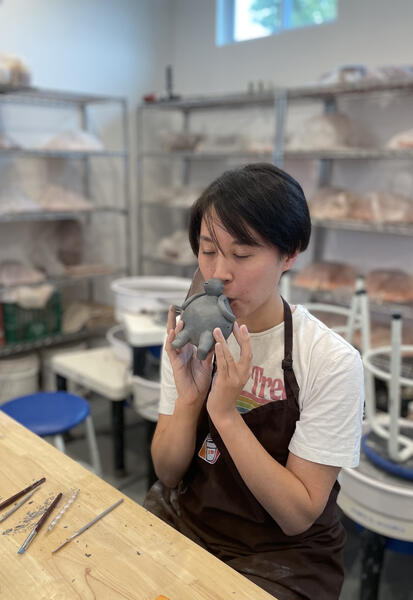 Flute-making workshop at Washington Street Studios in Harpers Ferry, West Virginia
Flute-making workshop at Washington Street Studios in Harpers Ferry, West VirginiaIn 2021 I gave a flute-making intensive workshop over the course of two days at Washington Street Studios in Harpers Ferry. Participants were introduced to different Pre-Columbian instruments, and learned to build a simple ocarina and a sculptural ocarina.
I really enjoy teaching ocarina-making, because it's an instrument that anyone can make and that anyone can pick up and play. Ocarinas are constructed in such a way that- if we know how to breath, we can play them! This instrument allows for us to be able to engage in an intuitive and playful way, cultivating a connection with music-making that we sometimes don't allow ourselves to explore otherwise.
-
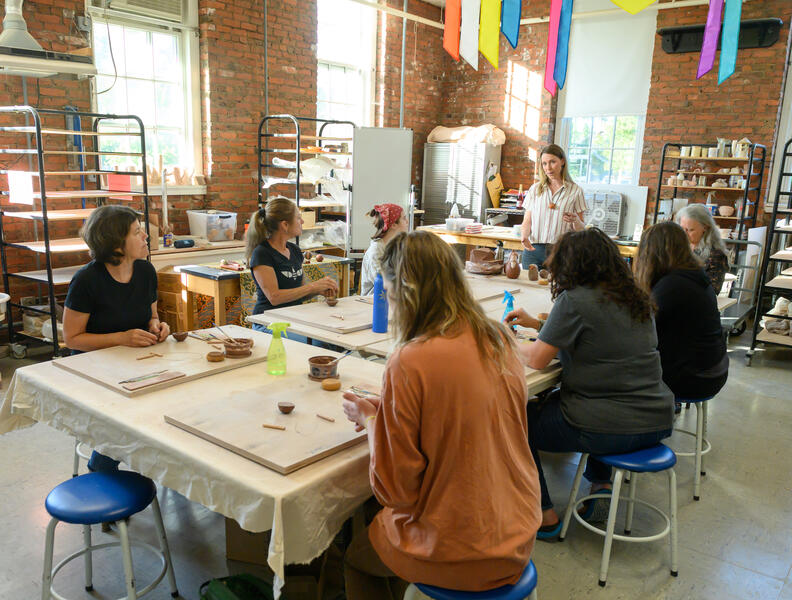 Flute-making workshop at Maryland Hall for the Creative Arts in Annapolis
Flute-making workshop at Maryland Hall for the Creative Arts in AnnapolisIn 2023 I gave a series of Mud to Music instrument-making workshops at Maryland Hall for the Creative Arts in Annapolis, with the support of an Arts in Education grant from the Maryland State Arts Council.
Throughout the course of these workshops; half of which were given in English and half in Spanish, participants learned to make clay flutes and rattles with time-honored hand building techniques and simple pottery tools.
© Maryland State Arts Council 2025, MSAC.org
Original Instruments: Heron Horn
When I was little we would stop in the car at a specific spot on the Lamoille River in Northern Vermont where I was born. We’d sit and wait to see if we got lucky enough that day to get to see Great Blue Heron fishing. Those early mini bird watching expeditions implanted in me a special fondness for this majestic bird.
While I was puzzling over the design of this instrument, I went for a walk along Gunpowder River here in Baltimore. That day I got lucky to spot Great Blue Heron fishing in the middle of a shallow section of river. I sat on a big stone in the sun and watched her for a long time, noticing her patience, how her neck straightened and then bent into a graceful curve, and the way her legs folded as she carefully walked through the water.
Original Instruments: The Place-Based Creation of Mente Mineral (Mineral Mind)
From January 19-29th, 2023 I participated in an intensive 10-day training in research, study, and creation with clay as living material, that took place in the Patagonian province of Chubut, Argentina organized by Nómada Cerámica. This opportunity for professional development was supported by a grant from the Maryland State Arts Council.
During the residency we responsibly harvested local clay from the local mountain range, which once formed part of the Gondwana supercontinent. We worked with two materials; one dating to the Miocene (13 million year old material) and the other dating to the Paleocene period (66 Million year old material).
We completed a process of testing with the clays, and proceeded to develop and prepare a clay body as a group, to use in the fabrication of our own individual creations. We completed the residency by building a temporary outdoor kiln and completing a 6 hour wood-firing before closing the residency with an improvisational performance in the mountains.
-
Mente Mineral (Mineral Mind)
This music mask produces sound with internal bells and two small flutes that have two finger holes each. The flutes can be played separately or together to produce melodies and beat frequencies.
Photo by Julieta Bilbao of Nómada Cerámica.
-
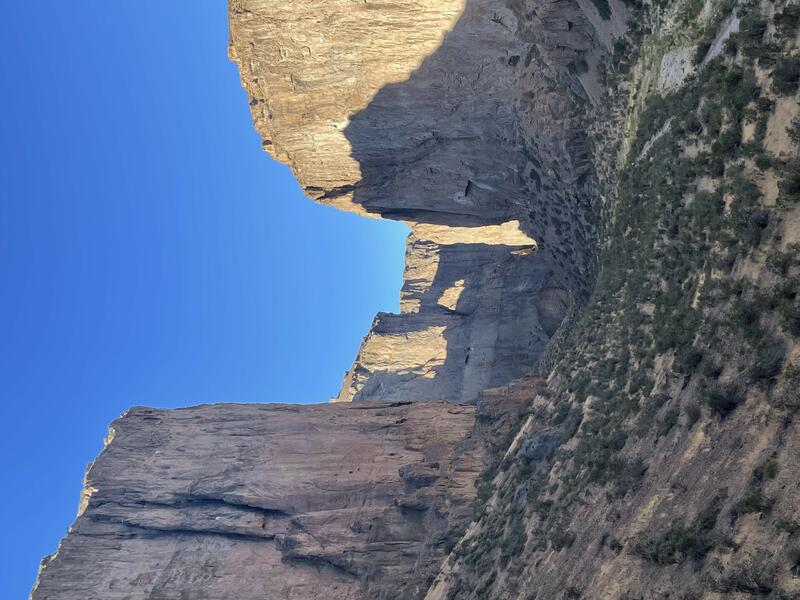 Mountains in Chubut, Argentina
Mountains in Chubut, Argentina -
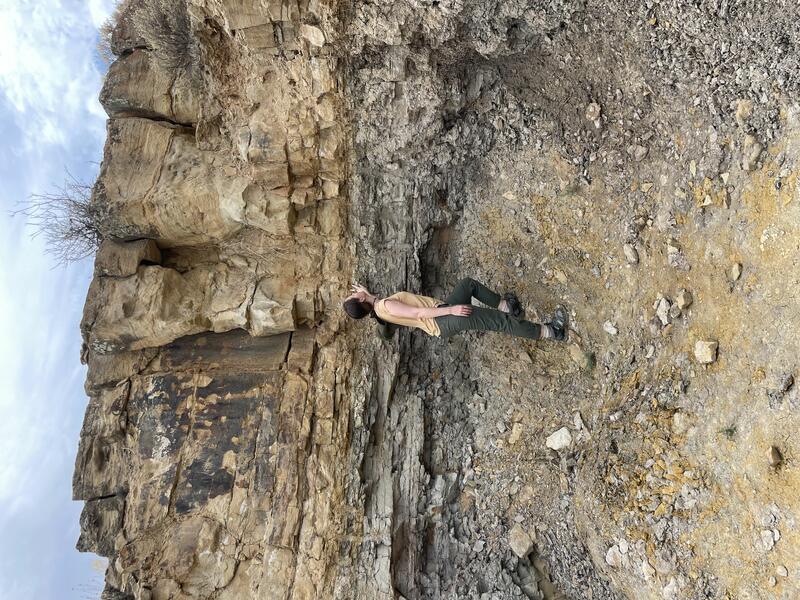 First encounter with local clay in situ
First encounter with local clay in situ -
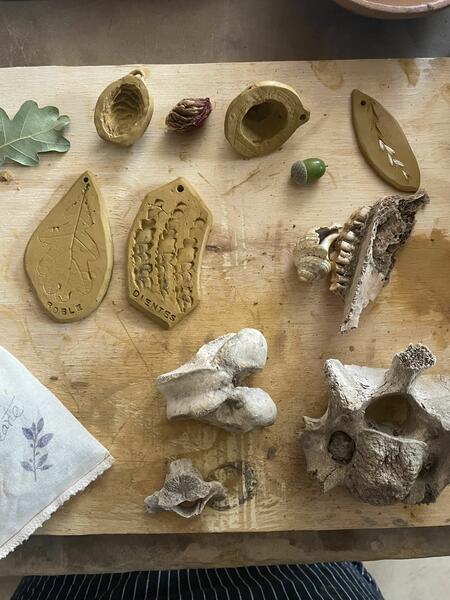 Gathering inspiration in form and texture from the local landscape
Gathering inspiration in form and texture from the local landscape -
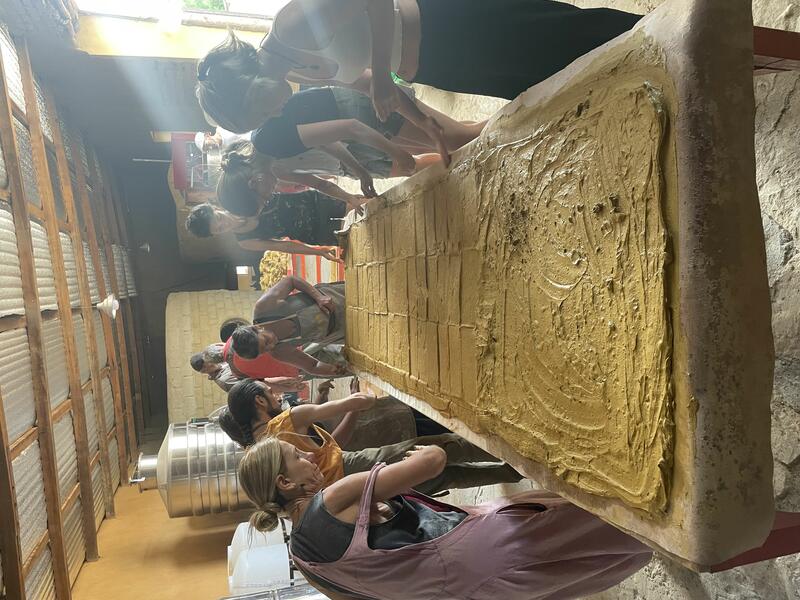 Communal preparation of the clay body
Communal preparation of the clay body -
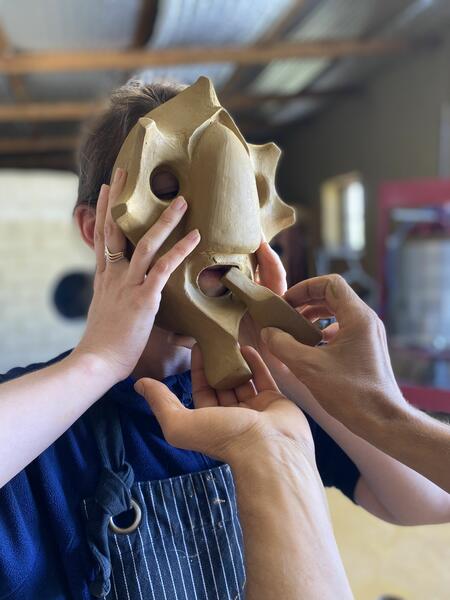 Mente Mineral (Mineral Mind) in process
Mente Mineral (Mineral Mind) in process -
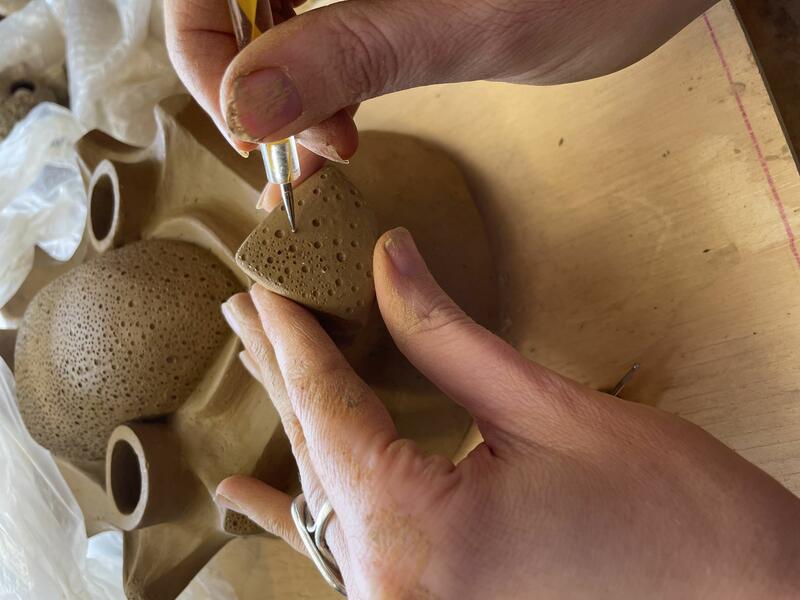 Mente Mineral (Mineral Mind) in process
Mente Mineral (Mineral Mind) in process -
Mente Mineral (Mineral Mind) heading into the outdoor kiln for firing
-
Mente Mineral (Mineral Mind) emerges from the fires
-
Applying beeswax as a finishing technique
Musical Composition: Whewan
Electroacoustic composition for electronic instruments, tree branch, handcrafted horn and flutes, and voice.
“Whewan” is an Orkney (Scotland) word for wind that howls around corners; the imagery and mood of this word feel perfect for this piece.
For this composition, which was created through an extended session of improvisation, I played original instruments: Heron Horn and Ancestor's Double Flute, as well as an historic recreation of a rare type of flute from the Pre-Columbian culture Jama-Coaque (of present-day Ecuador). The piece was recorded, composed and produced using Ableton Live.
Read more about the Jama-Coaque here
-
No video provider was found to handle the given URL. See the documentation for more information.Whewan
-
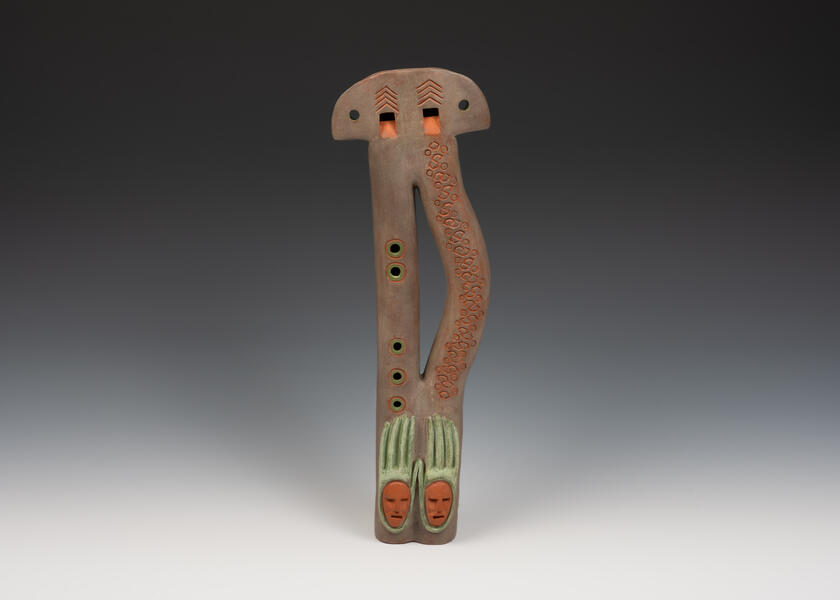 Ancestor's Flute
Ancestor's Flute2023
12 x 3 3/4 x 1 in
Earthenware, oxides, pigments
Original instrument composed of two tubular flutes; one with pentatonic tuning and the other which acts as a drone producing a single note when played. The flutes have separate air channels which allow them to be playing individually or together.
Polyphonic flutes are tubular duct flutes where one instrument can be made up of two, three, or even four different flutes. Oftentimes the flutes have separate air channels so that they can be played individually or in different combinations. These types of flutes were common to Mesoamerica, made by cultures like the Colima, Aztec, and Maya.
-
Historical Recreation of a Jama-Coaque Flute
2021
7 1/2 x 2 1/2 x 2 in
Earthenware, oxides
I was instructed in the creation of this ancient flute by one of my teachers, Estéban Valdivia, who received presidential permission to study instruments in the archives of all of Ecuador's museums. Being able to analyze broken historic artifacts, as well as completing x-ray scans of intact instruments, allowed Valdivia to study the inner workings of this complex flute in detail to understand the construction of the two internal whistles hidden within the abdomen of the flute.
Because of the particular construction of the acoustic system, this flute has a very particular, airy timbre.
-
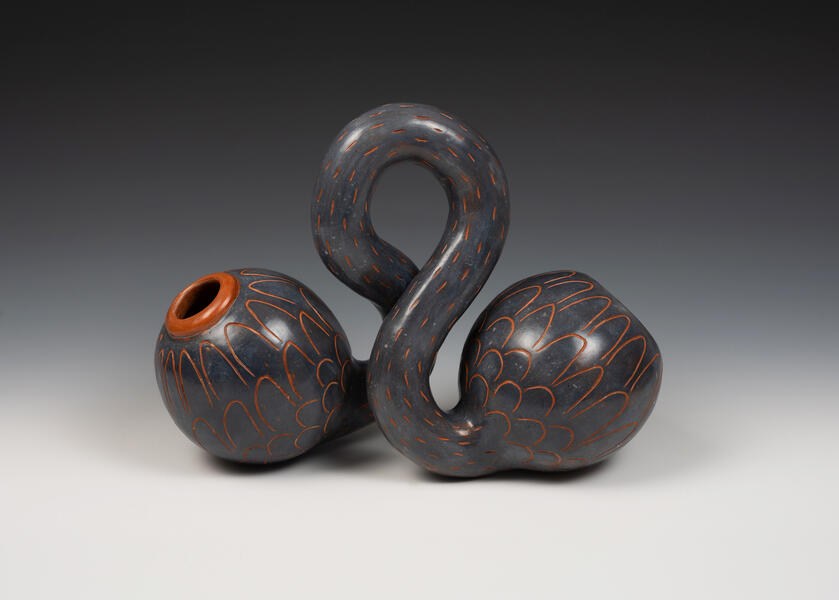 Heron Horn
Heron Horn2023
10 ½ x 4 x 8 in
Earthenware, oxides, pigments, beeswax
Horn inspired by Great Blue Heron. This sculptural instrument can be played in different ways to produce sounds ranging from percussive to bird-like calls to deep vibrating drones.
The shape, design, and coloring of the instrument is inspired by the morphology of Great Blue Heron, who has been an important bird throughout my life story.
The trumpet was one of the most significant musical instruments in the pre-Columbian Andean World, in terms of denotation of power. These “natural” trumpets or horns were made of clay or conch shell and produced a single pitch. However, a skilled trumpeter could produce different tones through varying lip vibration and air pressure.
Community Engagement: MD Traditions Artist in Residency at UMBC
From AY24-25 I am serving as the MD Traditions Artist-in-Residence at UMBC. In Fall 2024 I shared instrument-making practices with UMBC undergraduate Linehan Artist Scholars (LAS) over the course of three sessions. Scholars were introduced to historic ceramic instruments of Central and South America, like whistling bottles, polyphonic flutes, rattles and ocarinas, before learning through a step-by-step process to build their own unique clay flutes (ocarinas).
On December 6th, 2024, we collaborated on a public presentation at UMBC. Scholars received their flutes back from firing, and proceeded to explore their sounds before working to develop a graphic score that they then performed as a group.
During the spring semester, I will work with LAS to develop a “Teaching Box”, which will consist of teaching materials that will enable art teachers in public schools to introduce their students to the practice, history, and cultural significance of clay instrument making.
-
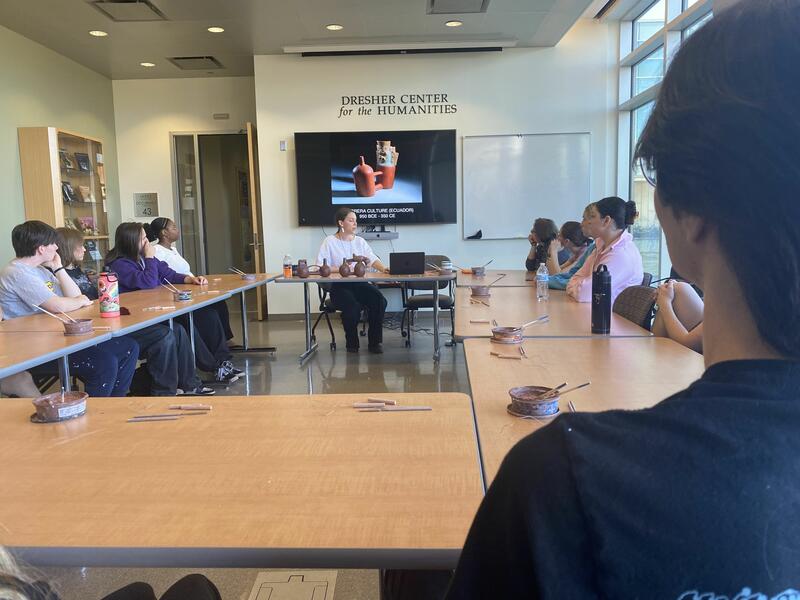 Linehan Artist Scholars learn about historic ceramic musical instruments of Central and South America through an audiovisual presentation
Linehan Artist Scholars learn about historic ceramic musical instruments of Central and South America through an audiovisual presentation -
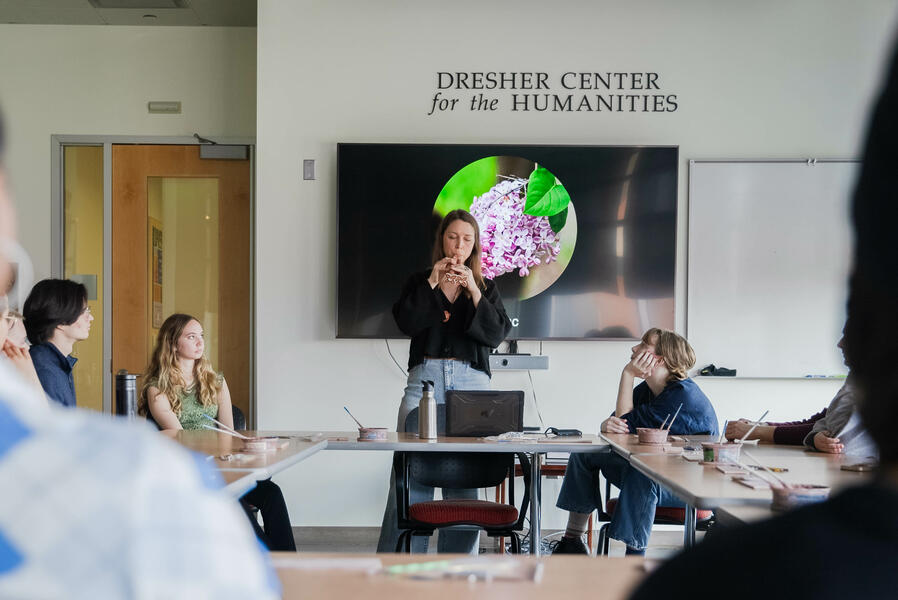 Demonstrating a Lilac Double Flute
Demonstrating a Lilac Double FluteAs part of our Fall sessions, I brought in a collection of my own original instruments which reimagine Pre-Columbian sound technologies through the lens of personal narrative and regional mythology.
This image shows a demonstration I gave with my Lilac Double Flute. Polyphonic flutes are tubular duct flutes where one instrument can be made up of two, three, or even four different flutes. Oftentimes the flutes have separate air channels so that they can be played individually or in different combinations. These types of flutes were common to Mesoamerica, made by cultures like the Colima, Aztec, and Maya.
This instrument is my own version of a flower flute, inspired by Lilac, with whom I feel a sense of kinship.
© Maryland State Arts Council 2025, MSAC.org.
-
Scholars begin the process of making their own unique clay flutes (ocarinas)
-
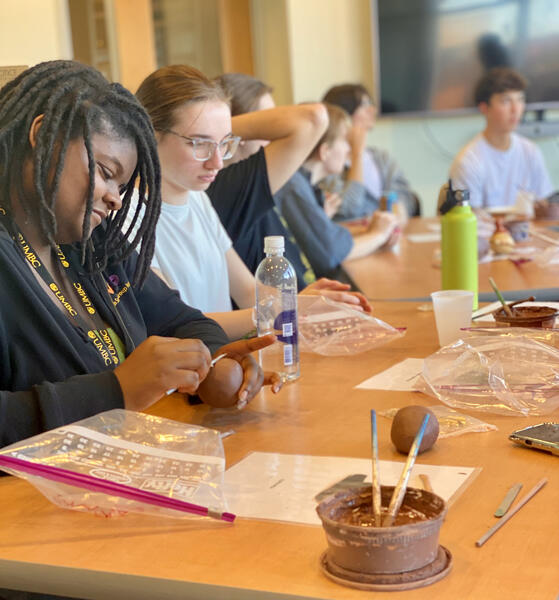 Process: Clay flute making
Process: Clay flute makingStudents work through a step-by-step process using hand-building techniques and simple pottery tools to construct their own unique ocarinas, or clay flutes.
The Ocarina is a vessel, globular, or globe flute. Ocarinas are one of the most widely known and popular ceramic instrument of all time, with traditions in virtually all parts of the world. They have been made since prehistoric times, from a variety of materials. Although the name “ocarina” was coined in 19th century Italy, the instrument itself has a much longer history. Early inhabitants of Mesoamerica and South America were prolific ocarina designers and builders for thousands of years. The variety and creativity of their globular flutes is remarkable and unparalleled, with ocarinas made in the form of different birds, animals, reptiles, fruits, vegetables, and deities.
Each student was encouraged to explore their own creativity through tuning and decorating their flutes. As a result, even though we all made the same kind of instrument, each flute was completely unique in both sound and form.
-
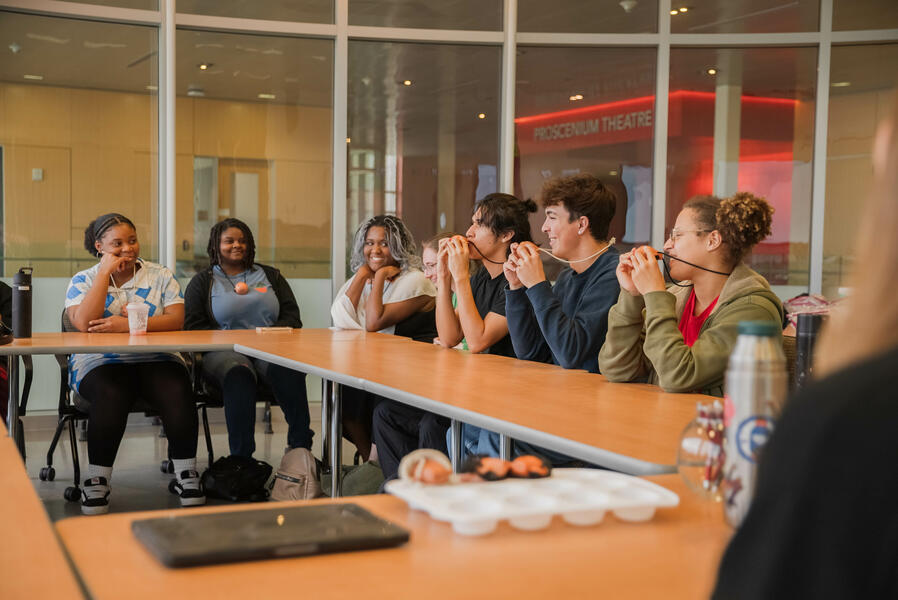 Students practice playing clay flutes (ocarinas)
Students practice playing clay flutes (ocarinas)Over the course of our Fall sessions, I brought in a set of my own hand built ocarinas, so that scholars could begin to get familiar with the mechanics of the instrument. We used guided improvisation exercises to practice listening to one another and playing the instruments, in preparation for the public presentation we would give with our own flutes after their firing.
© Maryland State Arts Council 2025, MSAC.org.
-
Students get their clay flutes back from firing
-
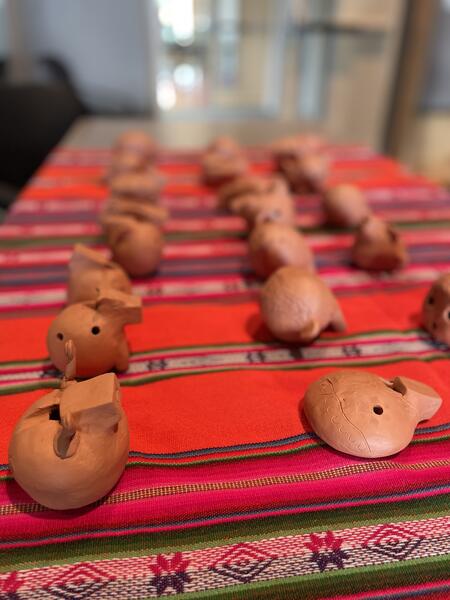 Clay ocarinas: Student work
Clay ocarinas: Student work -
Scholars explore their hand-built instruments and begin to develop graphic scores
In preparation for our public presentation at UMBC, scholars spent time exploring their unique instruments and developing sonic gestures and accompanying symbols that we then used to create a graphic score to perform.
-
Linehan Artist Scholars public presentation performance at UMBC in December 2024
Original Instruments: Sweet Gum Rattles
Vessel rattles (also called shakers or maracas) consist of a vessel filled with loose pellets. Early rattles were made from a wide variety of materials, such as dried gourds, fruit, seaweed, seed pods, tortoise shells, leather, and other natural materials. Examples of ancient clay rattles have been found all over the world. Rattles are one of the oldest instruments and in many societies, they are associated with the supernatural and accompany religious rites.
These rattles are inspired by the spikey seed pods of Sweet Gum tree. Each rattle has a different quantity and size of pellets, resulting in a slightly different timbre of sound when played.
My body holds vivid memories of summer rainstorms that I experienced as an adolescent growing up in Maryland. Somedays it would get so humid and so hot that it became unbearable, until finally the rains would let loose. Then the skies would open up and, however briefly, release a deluge of warm rain. My best friend and I would run out into the streets in our t-shirts and bare feet to stomp around in the storm. The only thing that could possibly foil our unbridled joy was stepping on Sweet Gum seed pod hidden in the sudden flood waters.
Earthenware, oxides, pigments, beeswax
7.25 x 3.5 x 3.5 in each
2024


